How to make Katsu Sando with chef Tim Anderson
MasterChef winner Tim Anderson gives us his tips on how to make the ultimate Japanese Katsu Sando sandwich.


If you are a Katsu curry lover, you are going to love these Katsu Sando sandwiches, filled with delicious crunchy breadcrumbed pork cutlets, sweet, shredded cabbage, tonkatsu sauce, and plenty of mayonnaise.
Katsu is short for Katsuretsu in Japanese, which means fried pork or chicken cutlet, like in a popular Katsu curry dish and Sando is the term used for the sandwich. Personally, we think it is the coolest sandwich we have ever seen and is one of our favourite Japanese recipes.
We asked MasterChef winner and owner of Nanban restaurant in Brixton, Tim Anderson for his favourite Katsu Sando recipe along with his top tips which includes why you "should not flatten your pork, as it will cook too quickly if you do, resulting in dry meat."
When following this recipe, keep in mind that it serves four. We think it is perfect for lunch or even as a fancy picnic treat. If you are not a pork fan, we suggest using chicken fillets or if you are vegetarian, try it with Quorn vegetarian fillets.
Preparation: A key thing to bear in mind when making Katsu Sando sandwiches is to allow time, as they are not as quick as your average sandwich as you have to allow for the meat to tenderise for an hour.
Another thing is to make sure you have meat tenderiser powder (not if you are using chicken or Quorn), this makes sure your pork cutlets are super tender and tasty and your sandwiches won't taste as good without it.
Also ingredients such as Kewpie mayo and Tonkatsu sauce you will not be able to get in your normal supermarkets, you will have to order these essential ingredients online or head to your local Japanese supermarket. Trust us, these sandwiches make it worth searching for all the ingredients and are used in many of our favourite Japanese recipes too.
GoodtoKnow Newsletter
Parenting advice, hot topics, best buys and family finance tips delivered straight to your inbox.
Watch Tim Anderson make the ultimate Katsu Sando sandwiches
Ingredients:
- 4 pork loin cutlets/steaks, about 1-1.5cm thick
- salt
- meat tenderiser powder
- white pepper
- 50g strong white bread flour
- 2 eggs, beaten with 1 tbsp oil
- 120g panko
- oil, for deep-frying
- 8 slices soft yet sturdy white bread (cut the crusts off for an authentic conbini experience)
- 4 tbsp Kewpie mayo
- ½ hispi cabbage, finely shredded
- 100ml tonkatsu sauce
How to make Katsu Sando
Step 1
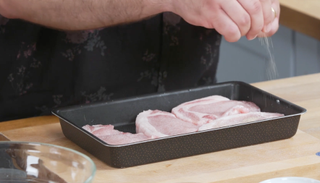
Sprinkle each cutlet with salt, a tiny bit of tenderiser, and white pepper, and rub the seasoning in.
Step 2
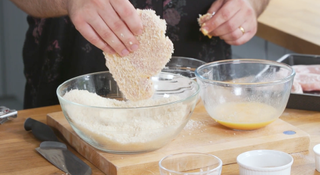
Leave to sit for one hour, then dredge in the flour, then the eggs, and then the panko, ensuring the chops are very well coated.
Step 3

Heat the oil to 180ºC and fry the chops for about 5 minutes, until the pork is just cooked through – it is ok if it’s still a little pink. Drain on paper towel and leave to cool slightly.
Step 4
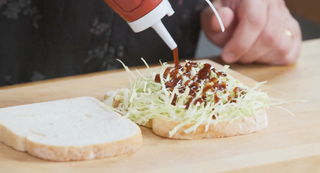
To construct the sandwich, spread the mayo on one piece of bread, then top with a handful of cabbage. Put a little tonkatsu sauce on top of the cabbage, then put the tonkatsu on top of that and add a little more tonkatsu sauce.
Step 5

Finally, top with the other piece of bread, squish it down, and slice in half. These are nice warm but they’re also perfectly delicious cold, and their texture will be okay after 24 hours in the fridge, provided your bread isn’t too dry and flimsy.
Things to know about Katsu sando
Why can you only use pork loins for Katsu Sando?
Expert Tim Anderson says; "boneless pork loins are a better choice of cut for Katsu Sando sandwiches, as they are a good balance of fat and lean meat."
Pork is tender enough so you can eat the sandwiches easily and loins will not have a chewy texture compared to other cuts and are the perfect size to slot into your bread.
They should be around 1.5cm thick, as you want them to be not too thick so that they are hard to cook, but not too thin that the meat easily dries out when fried.
How to store leftover Katsu Sando
The pork loins used in your Katsu Sando, you can refrigerate for up to three to four days so you can continue to make these delicious sandwiches throughout the rest of your week or weekends, without the hassle of cooking.
If you want to keep your loins even longer, you can freeze them and it is said that they will maintain their best quality for up to 2-3 months.
The key is to make sure you store them in airtight containers or sealed bags in both your fridge or freezer to keep them fresh.
Our best Japanese recipes
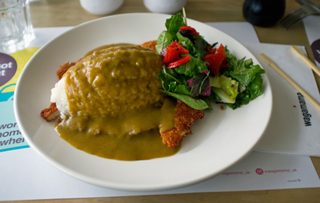
1. Chicken katsu curry
A delicious dish of chicken stock, coconut milk, and soy sauce, along with onions, garlic, and ginger - not forgetting tender chunks of chicken. A mouthwatering choice packed with flavour. Wagamama's most popular dish.
Get the recipe: Wagamama's chicken katsu curry
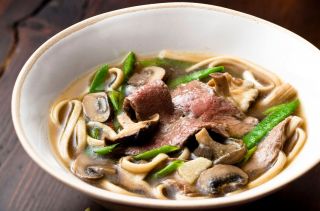
2. Japanese broth with udon noodles
This super healthy dish is low-calorie and super high in nutrients. You can also make this meaty soup completely suitable for vegetarians and vegans by choosing vegetable stock and soy and replacing the steak with mushrooms.
Get the recipe: Japanese broth with udon noodles

3. Chicken gyoza with spring onion and sprouts
These are the perfect Japanese appetizer or canape for your next dinner party, packed full of flavour and will definitely not disappoint.
Get the recipe: Chicken gyoza with spring onion and sprouts

4. Miso prawn skewers
We guarantee that these miso prawns will make you obsessed with Japanese cuisine. They are the perfect starter or canapes and take under 10 minutes to cook.
Get the recipe: Miso prawn skewers

5. Fluffy Japanese pancakes
Known as Japanese soufflé pancakes, they are the biggest pancakes we have ever seen and make for a great sharing dessert.
Get the recipe: Fluffy Japanese pancakes

Tim Anderson is an American-British chef, who specialises in Japanese food and gastronomy. Currently executive chef and owner of Nanban, with branches in Brixton and Convent Garden and author of five Japanese cookbooks, his career took off when he won MasterChef in 2011. Since then, he has developed a career as not only a professional chef, but a restaurateur, a writer and radio and TV personality, where he has featured as a panelist on BBC Radio 4 The Kitchen Cabinet, and has contributed to articles in The Guardian, National Geographic Traveller, The Telegraph, Newsweek, and Vittles.
Related features:
How to make scotch eggs with Tim Anderson
How to make chicken karaage with Tim Anderson
How to make chorizo with Joe Howley

Christina Geggus is Junior Food Writer at Goodto.com and enjoys writing about lifestyle, food, and recipes. After completing her Master’s in Magazine Journalism at Nottingham Trent University and her undergraduate degree in Communication & Society and Global Studies alongside receiving an NCTJ diploma, Christina has always set her sights on a career in journalism.
- Rosie ConroyFood Writer